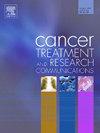The emerging role of blood-based biomarkers in early detection of colorectal cancer: A systematic review
Q3 Medicine
引用次数: 0
Abstract
Background
Colorectal cancer (CRC), the third most commonly diagnosed and second most lethal cancer worldwide, necessitates efficient early detection strategies to improve patient outcomes. This review evaluates the promise of novel blood-based biomarkers for early detection of CRC.
Methods
A systematic review, registered with PROSPERO (CRD42024513770) and adhering to PRISMA guidelines, was conducted across multiple databases from January 1st, 2020 to December 31st, 2022. The comprehensive search strategy centered on sensitivity, specificity, and AUC-ROC of multiple types of molecular blood biomarkers.
Results
Of total of 142 included articles, 59 were on protein, 58 on RNA, and 21 on DNA. The investigation into DNA biomarkers revealed that cfDNA and ctDNA carry significant potential for early CRC diagnosis. For instance, methylation patterns in genes such as MYO1-G and NDRG4 exhibited high diagnostic accuracies with AUCs reaching up to 0.996. RNA biomarkers like miRNAs and circRNAs also showed promising results, with circ_0011536 achieving AUCs of 0.982. Protein biomarkers, contrasted with established cancer markers, unveiled notable candidates like Irisin and ANXA2, with AUCs surpassing 0.96. The review highlights several individual markers and panels with the potential to improve upon existing CRC screening tests.
Conclusions
Despite the promise shown by the novel biomarkers, challenges persist, including small sample sizes, potential selection biases, and a lack of comprehensive cost-effectiveness analysis. Future research should focus on large-scale, multicenter, prospective studies across diverse populations. The findings advocate for an integrated biomarker approach, potentially revolutionizing CRC screening and aligning it with clinical realities through rigorous validation.
求助全文
约1分钟内获得全文
求助全文
来源期刊

Cancer treatment and research communications
Medicine-Oncology
CiteScore
4.30
自引率
0.00%
发文量
148
审稿时长
56 days
期刊介绍:
Cancer Treatment and Research Communications is an international peer-reviewed publication dedicated to providing comprehensive basic, translational, and clinical oncology research. The journal is devoted to articles on detection, diagnosis, prevention, policy, and treatment of cancer and provides a global forum for the nurturing and development of future generations of oncology scientists. Cancer Treatment and Research Communications publishes comprehensive reviews and original studies describing various aspects of basic through clinical research of all tumor types. The journal also accepts clinical studies in oncology, with an emphasis on prospective early phase clinical trials. Specific areas of interest include basic, translational, and clinical research and mechanistic approaches; cancer biology; molecular carcinogenesis; genetics and genomics; stem cell and developmental biology; immunology; molecular and cellular oncology; systems biology; drug sensitivity and resistance; gene and antisense therapy; pathology, markers, and prognostic indicators; chemoprevention strategies; multimodality therapy; cancer policy; and integration of various approaches. Our mission is to be the premier source of relevant information through promoting excellence in research and facilitating the timely translation of that science to health care and clinical practice.
 求助内容:
求助内容: 应助结果提醒方式:
应助结果提醒方式:


